1992 VOLKSWAGEN CARAVELLE engine
[x] Cancel search: enginePage 17 of 164

Downloaded from www.Manualslib.com manuals search engine
Seat
belts
CONTROLS AND EQUIPMENT
It has
been
proven
that
seat
belts
give
good
protection
in accidents. In
most
countries
therefore
the
wear
ing of
seat
belts
is
required
by law.
Attention
The
belts
should be put on
before
every
journey
-
even
in
town
traffic.
This
applies
also to the
rear
seats.
Pregnant
women
too should al
ways
wear
a
seat
belt.
The
routing
of the
belt
is of
major
importance
to the
protective
ef
fect
of the
belt.
How the
belt
should be
worn
is described on
the
next
pages.
General
notes
• The
belt
must
not be
twisted.
• Two persons
(including
children)
must never be secured
with
one belt. It is
particularly dangerous to put the belt round
a
child sitting on a persons lap.
• The belt should not be worn over hard or
breakable
articles (glasses, ball pens, key
rings,
pipes, etc.) because this can cause in
jury
to the body.
•
Loose,
bulky clothing (e.g. overcoats
over
jackets) affects the fit and function of
the belts.
• The belt must not be jammed anywhere or rub on any sharp edges.
• The lock tongue may only be inserted into the lock part belonging to the appropri
ate seat otherwise, the protective effect is
impaired.
• The slot for the belt tongue rr„s: -;: ze
blocked
with
paper or anyth'-c s ~
otherwise the tongue cannot 5"a;e properly.
• The belts must be kept clean otherwise the retractors may not work properly (see
also
"Care
of car" section).
• Seat belts which have become damagec or have been stressed in an accident and stretched must be renewed - preferably by
a
Volkswagen dealer. The anchorages
should
also be checked.
• In some export countries seat belts
could
be used on which the functions differ
from those described on the next pages.
• On the Delivery Van there are no belt an
chorage
points in the load compartment.
-DW
children can be carried safely in the ve- " cle is explained on page 18.
www.vwT4camper.info - a useful website for owners and enthusiasts of VW T4 Transporter Campervans
Page 18 of 164

Downloaded from www.Manualslib.com manuals search engine
CONTROLS AND EQUIPMENT
Three-point
inertia
reel
belts
The
inertia reel belt gives complete freedom
of movement when pulled slowly. Sudden braking however will cause the belt to lock.
The
mechanism will also lock the belt when
accelerating,
driving down steep gradients
or cornering.
Putting
belt
on
Pull
the tongue slowly and smoothly across
the chest and hips and push it into the lock part
fitted
on the seat until the tongue en
gages
audibly (pull to check).
The shoulder
part
of
belt
must
run
roughly
across the
centre
of the
shoulder as
shown
- on no account
against
the
neck
- and be
firmly
in
contact
with
the body.
The backrests of the
front
seats
must
not be inclined too far to the
rear,
otherwise
the
belts
are no
longer
fully
effective.
With the aid of the
belt
height
adjust
ment
the routing of the
front
seat shoulder
belt can be set to fit the body properly.
• To adjust, push button
with
relay
fitting
(see
right
illustration) up or down so
that
the
shoulder
part of belt runs roughly across the centre of the shoulder as shown on the
left
- on no account
against
the neck.
• After adjusting, pull the belt
with
a
jerk
to
ensure
that
the relay
fitting
is properly en
gaged.
16
www.vwT4camper.info - a useful website for owners and enthusiasts of VW T4 Transporter Campervans
Page 19 of 164
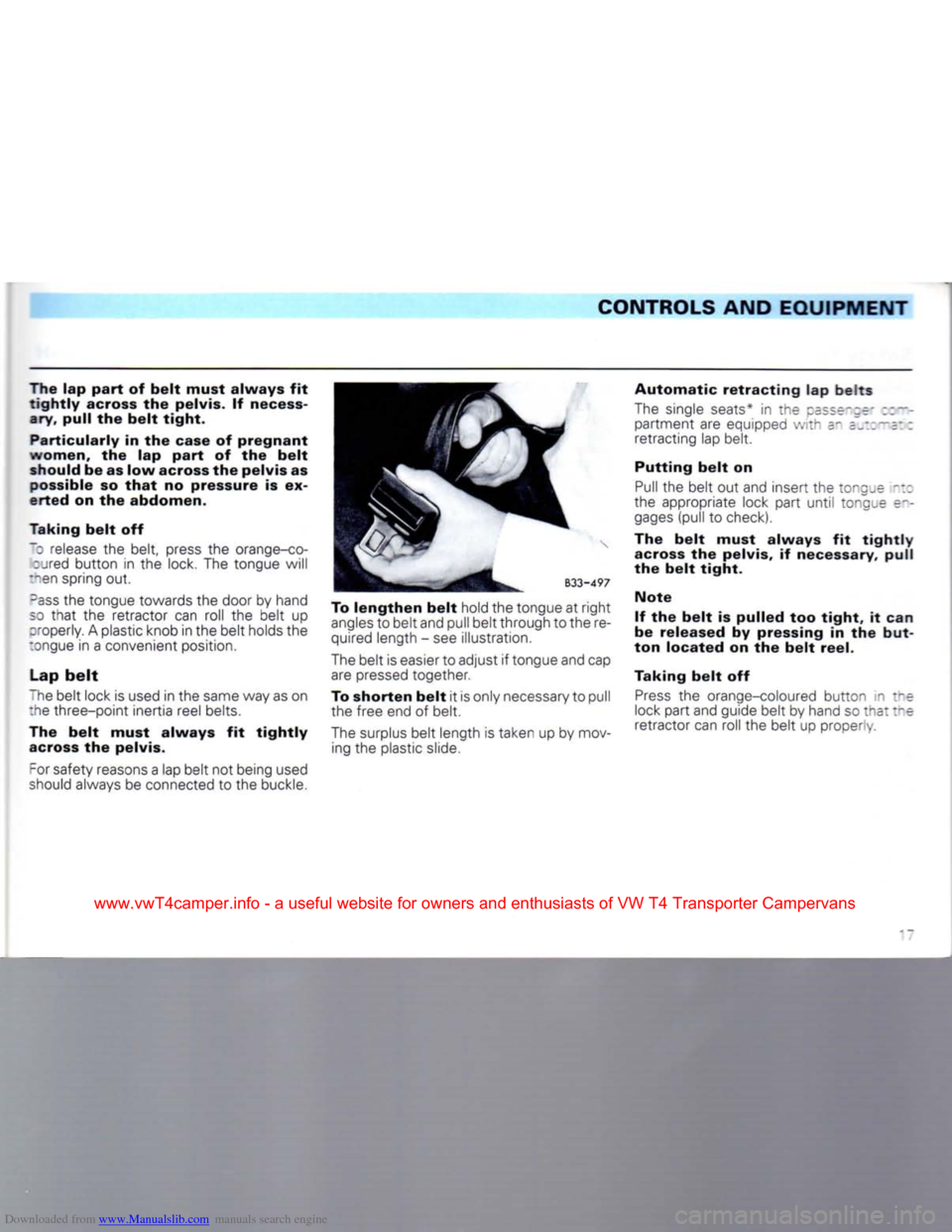
Downloaded from www.Manualslib.com manuals search engine
CONTROLS AND EQUIPMENT
The lap part of belt must always fit tightly across the pelvis. If necess
ary,
pull the belt tight.
Particularly in the case of pregnant
women,
the lap part of the belt should be as low across the pelvis as
possible so that no pressure is ex
erted on the abdomen.
Taking belt off
K release the belt, press the orange-co- :_red button in the lock. The tongue will
"en spring out.
-ass the tongue towards the door by hand
so that the retractor can roll the belt up
oroperly. A plastic knob in the belt holds the
:ongue in a convenient position.
Lap belt
The belt lock is used in the same way as on the three-point inertia reel belts.
The belt must always fit tightly across the pelvis.
For safety reasons a lap belt not being used
should always be connected to the buckle. To lengthen belt hold the tongue at right
angles to belt and pull belt through to the re
quired length - see illustration.
The belt is easier to adjust if tongue and cap are pressed together.
To shorten belt it is only necessary to pull
the free end of belt.
The surplus belt length is taken up by mov ing the plastic slide. Automatic retracting lap
beits
The single seats* in the ca;;e-;e'
;im
pertinent are equipped with =- —5; ;
retracting lap belt.
Putting belt on
Pull the belt out and insert the tors_e ~:
the appropriate lock part until tongue en gages (pull to check).
The belt must always fit tightly across the pelvis, if necessary,
pull
the belt tight.
Note
If the belt is pulled too tight, it can
be released by pressing in the
but
ton located on the belt reel.
Taking belt off
Press the orange-coloured button in the
lock part and guide belt by hand sc :na: :~s
retractor can roll the belt up properly.
www.vwT4camper.info - a useful website for owners and enthusiasts of VW T4 Transporter Campervans
Page 20 of 164
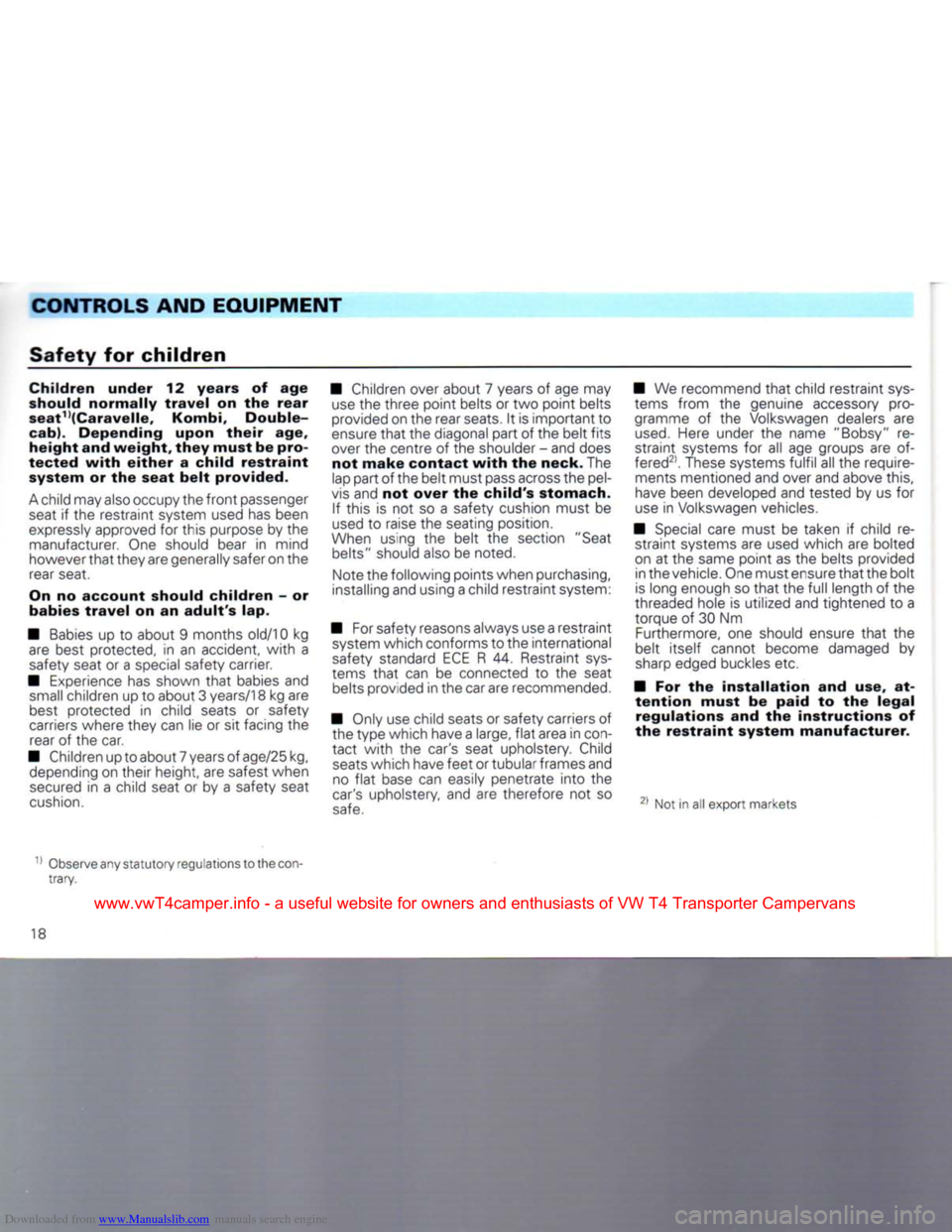
Downloaded from www.Manualslib.com manuals search engine
CONTROLS AND
EQUIPMENT
Safety
for
children
Children
under
12
years
of age
should
normally
travel
on the
rear
seat1>(Caravelle,
Kombi,
Double-
cab).
Depending
upon
their
age,
height
and
weight,
they
must
be pro
tected
with
either
a child
restraint
system
or the
seat
belt
provided.
A
child may also occupy the
front
passenger
seat
if the restraint system used has been
expressly
approved for this purpose by the
manufacturer. One should bear in mind however
that
they are generally safer on the
rear seat.
On no
account
should
children
- or
babies
travel
on an
adult's
lap.
• Babies up to about 9 months old/10 kg are best protected, in an accident,
with
a
safety seat or a special safety carrier.
• Experience has shown
that
babies and
small
children up to about 3 years/18 kg are
best protected in child seats or safety
carriers where they can lie or sit facing the rear of the car.
• Children up to about 7 years of age/25 kg, depending on their height, are safest when
secured
in a child seat or by a safety seat
cushion.
• Children over about 7 years of age may
use
the three point belts or two point belts
provided on the rear seats. It is important to
ensure
that
the diagonal part of the belt
fits
over the centre of the shoulder - and does not
make
contact
with
the
neck.
The
lap part of the belt must pass across the
pel
vis
and not
over
the child's stomach. If this is not so a safety cushion must be
used
to raise the seating position.
When using the belt the section "Seat belts" should also be noted.
Note the following points when purchasing,
installing and using a child restraint system:
• For safety reasons always use a restraint system which conforms to the international
safety standard ECE R 44. Restraint
sys
tems
that
can be connected to the seat belts provided in the car are recommended.
• Only use child seats or safety carriers of the type which have a large,
flat
area in
con
tact
with
the car's seat upholstery. Child
seats
which have feet or tubular frames and no
flat
base can easily penetrate
into
the
car's
upholstery, and are therefore not so
safe.
• We recommend
that
child restraint
sys
tems from the genuine accessory programme of the Volkswagen dealers are
used.
Here under the name "Bobsy" re
straint systems for all age groups are of
fered21.
These systems
fulfil
all the require ments mentioned and over and above this, have been developed and tested by us for
use
in Volkswagen vehicles.
• Special care must be taken if child re straint systems are used which are bolted
on at the same point as the belts provided in the vehicle. One must ensure
that
the bolt
is
long enough so
that
the
full
length of the
threaded hole is utilized and tightened to a
torque of 30 Nm
Furthermore, one should ensure
that
the
belt itself cannot become damaged by
sharp edged buckles etc.
• For the
installation
and use, at
tention
must
be
paid
to the
legal
regulations
and the
instructions
of
the
restraint
system
manufacturer.
Not in all export markets
Observe
any statutory regulations to the
con
trary.
18
www.vwT4camper.info - a useful website for owners and enthusiasts of VW T4 Transporter Campervans
Page 21 of 164
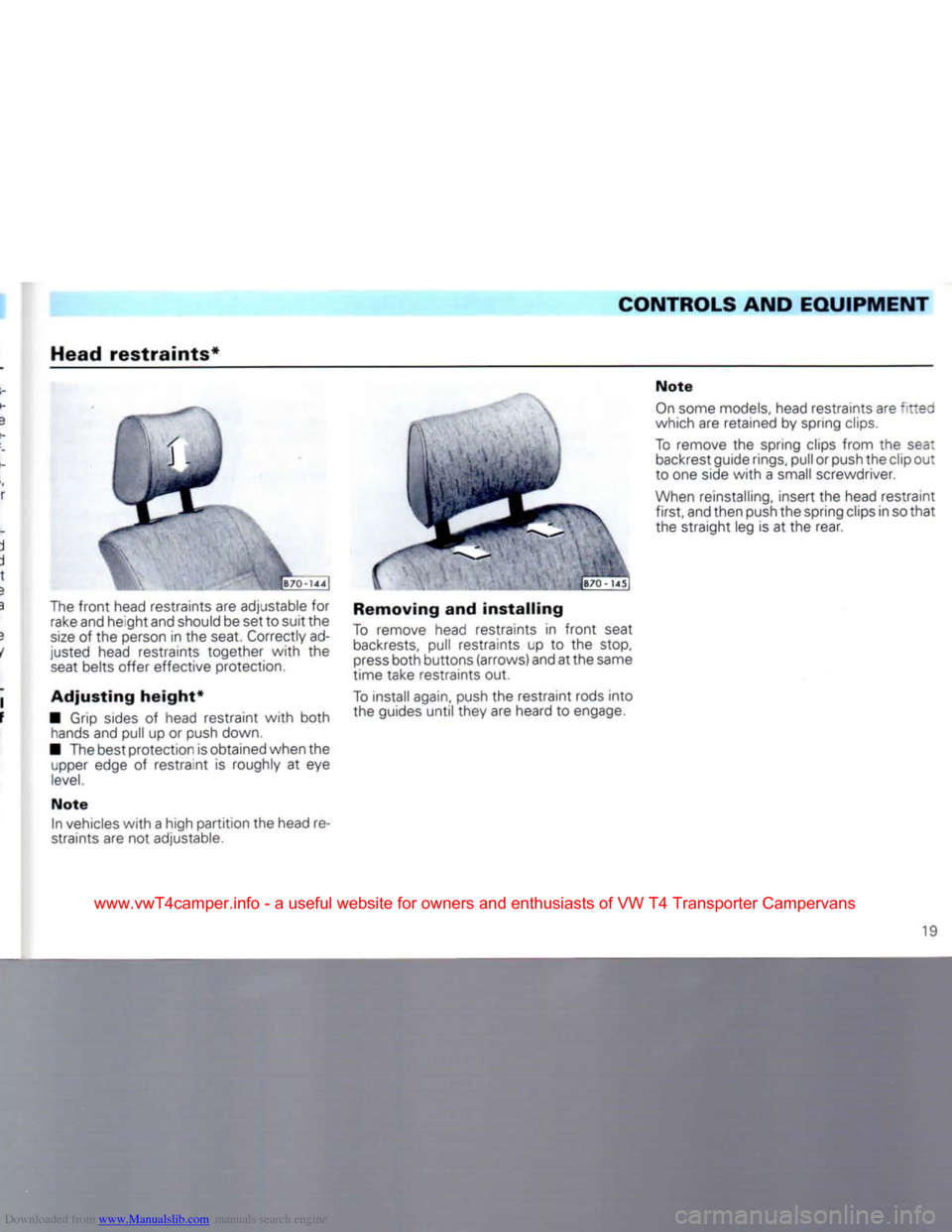
Downloaded from www.Manualslib.com manuals search engine
CONTROLS AND
EQUIPMENT
Head
restraints*
The
front
head restraints are adjustable for rake and height and should be set to suit the
size
of the person in the seat. Correctly ad
justed head restraints together
with
the
seat
belts offer effective protection.
Adjusting
height*
• Grip sides of head restraint
with
both hands and pull up or push down.
• The best protection is obtained when the upper edge of restraint is roughly at eye
level.
Note
In vehicles
with
a high partition the head re
straints are not adjustable.
Removing
and
installing
To
remove head restraints in
front
seat
backrests,
pull restraints up to the stop,
press
both buttons (arrows) and atthe same
time take restraints out.
To
install again, push the restraint rods
into
the guides
until
they are heard to engage.
Note
On
some models, head restraints are
fitted
which are retained by spring clips.
To
remove the spring clips from the seat backrest guide rings, pull or push the clip out
to one side
with
a small screwdriver.
When reinstalling, insert the head restraint
first,
and then push the spring clips in so
that
the straight leg is at the rear.
19
www.vwT4camper.info - a useful website for owners and enthusiasts of VW T4 Transporter Campervans
Page 22 of 164
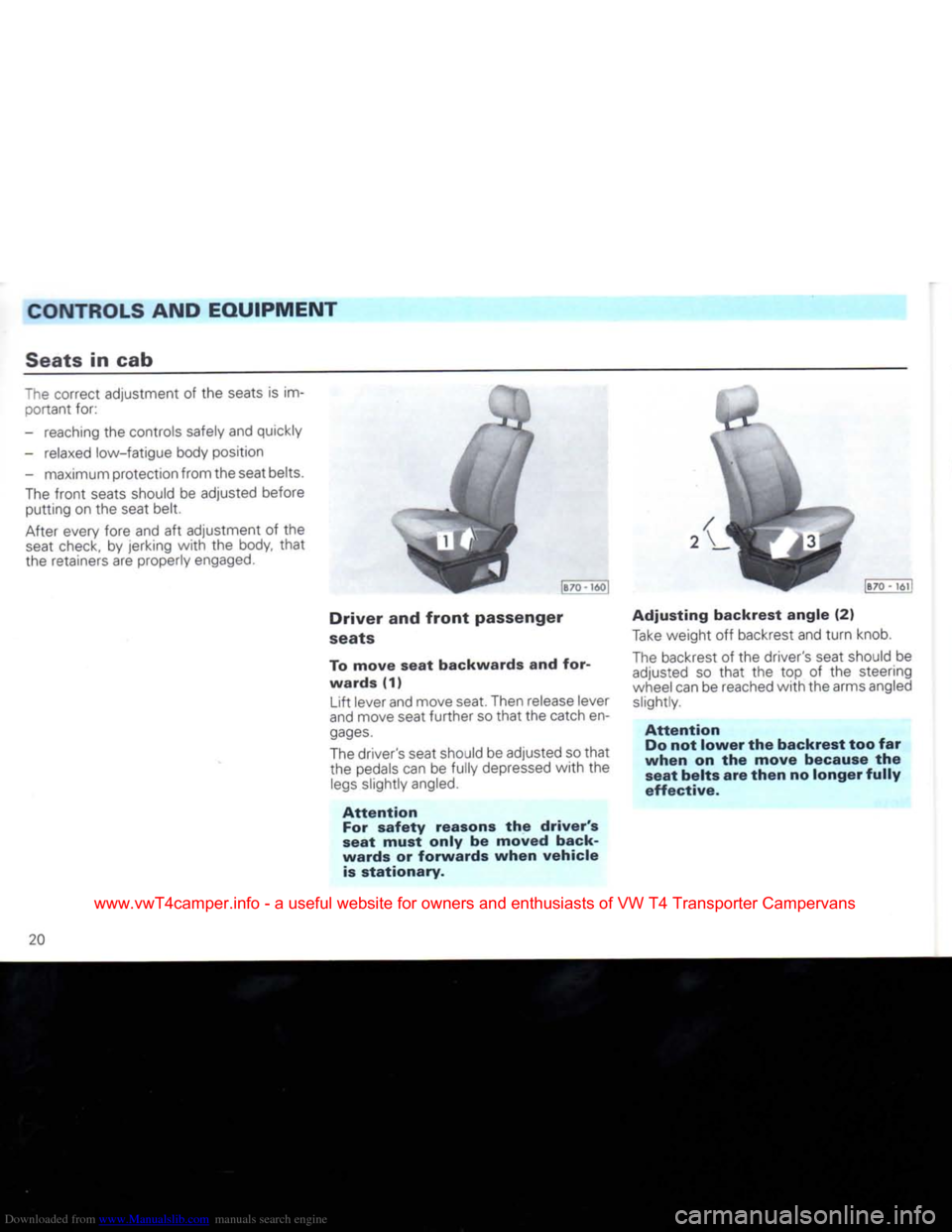
Downloaded from www.Manualslib.com manuals search engine
CONTROLS AND
EQUIPMENT
Seats
in cab
The correct adjustment
of the
seats
is im
portant
for:
- reaching
the
controls safely and quickly
- relaxed low-fatigue body position
- maximum protection from the seat belts. The
front
seats should
be
adjusted before
putting
on the
seat belt.
After every fore and
aft
adjustment
of the
seat
check,
by
jerking
with
the
body,
that
the retainers are properly engaged.
[B70-160J
Driver and front passenger
seats
To
move seat backwards and for wards (1)
Lift
lever and move seat. Then release lever
and move seat
further
so
that
the catch en
gages.
The driver's seat should be adjusted so
that
the pedals can
be
fully depressed
with
the
legs
slightly angled.
Attention
For
safety reasons the driver's
seat must only be moved back
wards or forwards when vehicle
is
stationary.
Adjusting
backrest angle (2)
Take
weight
off
backrest and
turn
knob.
The backrest
of
the driver's seat should
be
adjusted
so
that
the top of the
steering
wheel can be reached
with
the arms angled slightly.
Attention
Do
not lower the backrest too far
when on the move because the seat belts are
then
no longer fully
effective.
20
www.vwT4camper.info - a useful website for owners and enthusiasts of VW T4 Transporter Campervans
Page 23 of 164
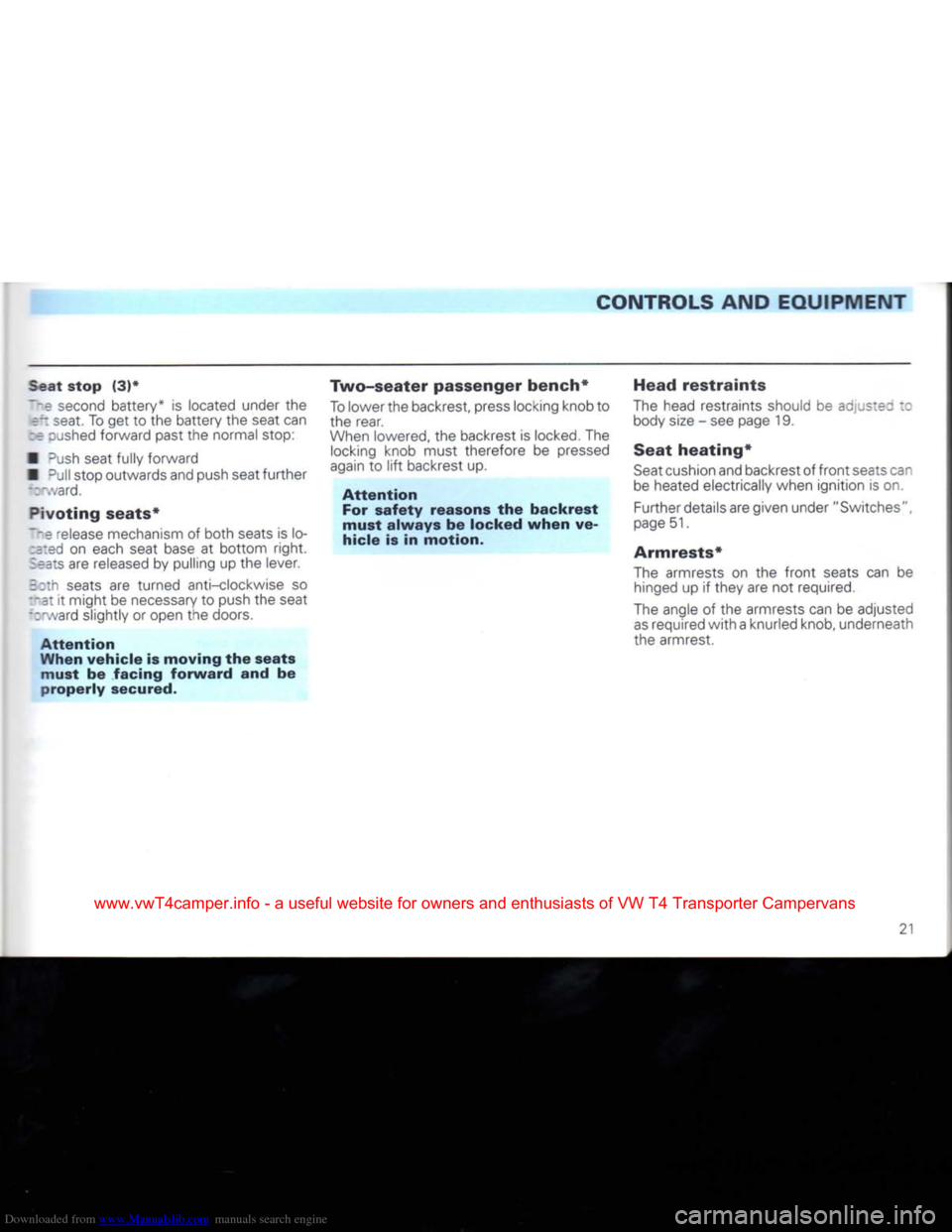
Downloaded from www.Manualslib.com manuals search engine
CONTROLS AND
EQUIPMENT
Seat
stop
(3)*
the second battery* is located under the •ft seat. To get to the battery the seat can
:e
cashed forward past the normal stop:
• Dush seat fully forward
• Dul stop outwards and push seat
further
":~.vard.
Pivoting
seats*
me release mechanism of both seats is lo rded on each seat base at bottom
right.
Seats
are released by pulling up the lever.
E::^
seats are turned anti-clockwise so
:~at it might be necessary to push the seat
':".vard slightly or open the doors.
Attention
When
vehicle
is
moving
the
seats
must
be
facing
forward
and be
properly
secured.
Two-seater
passenger bench*
To
lower the backrest, press locking knob to
the rear.
When lowered, the backrest is locked. The locking knob must therefore be pressed
again to
lift
backrest up.
Attention
For
safety
reasons the
backrest
must
always
be locked
when
ve
hicle
is in
motion.
Head
restraints
The head restraints should be ac _s:e; body
size
- see page 19.
Seat
heating*
Seat
cushion and backrest of
front
seats can
be heated electrically when ignition is on. Further details are given under "Switches",
page 51.
Armrests*
The armrests on the
front
seats can be hinged up if they are not required.
The angle of the armrests can be adjusted
as
required
with
a knurled knob, underneath
the armrest.
2!
www.vwT4camper.info - a useful website for owners and enthusiasts of VW T4 Transporter Campervans
Page 24 of 164
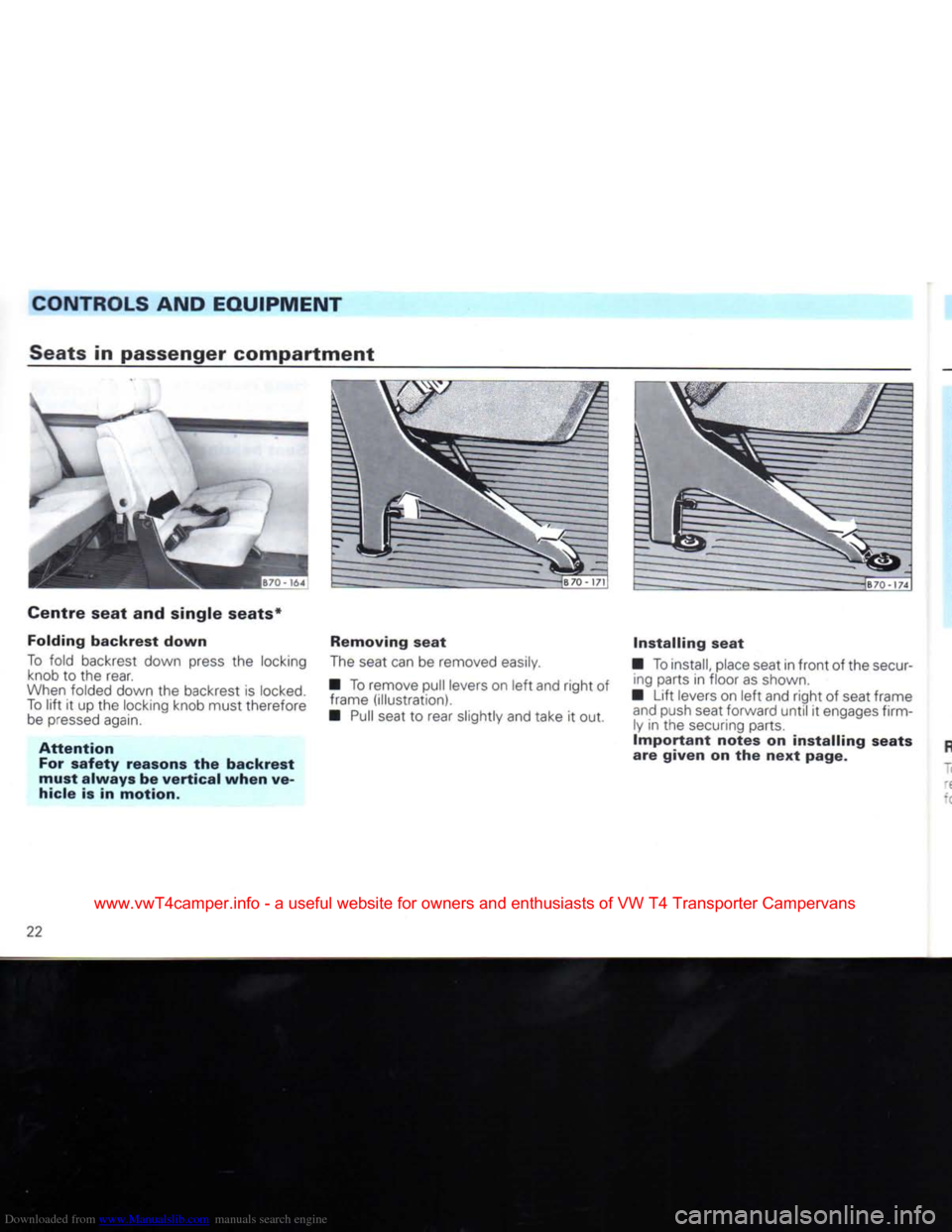
Downloaded from www.Manualslib.com manuals search engine
CONTROLS AND
EQUIPMENT
Seats
in passenger
compartment
Centre
seat
and
single
seats* Folding
backrest
down
To
fold backrest down press the locking knob to the rear.
When folded down the backrest is locked.
To
lift
it up the locking knob must therefore be pressed again.
Attention
For
safety
reasons the
backrest
must
always
be
vertical
when
ve
hicle
is in
motion.
Removing
seat
The seat can be removed easily.
• To remove pull levers on
left
and
right
of frame (illustration).
• Pull seat to rear slightly and take it out.
Installing
seat
• To install, place seat in
front
of the secur ing parts in floor as shown.
•
Lift
levers on
left
and
right
of seat frame and push seat forward
until
it engages firmly in the securing parts.
Important
notes
on
installing
seats
are
given
on the
next
page.
22
www.vwT4camper.info - a useful website for owners and enthusiasts of VW T4 Transporter Campervans